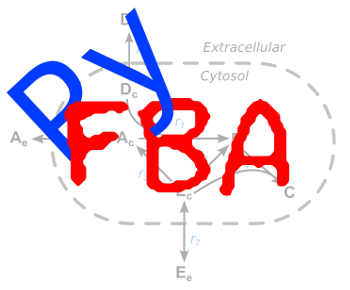Welcome to PyFBA¶
A python interface for Flux Balance Analysis
About PyFBA¶
PyFBA is a Python flux-balance-analysis package that allows you to build models from genomes, gapfill models, and run flux-balance-analysis on that model. The aim of PyFBA is to provide an extensible, Python-based platform for your FBA work.
PyFBA is being developed by Daniel Cuevas, Taylor O’Connell, and Rob Edwards in Rob’s bioinformatics group at San Diego State University together with help from Janaka Edirisinghe, Chris Henry, Ross Overbeek and others at Argonne National Labs.
Installing PyFBA¶
To use PyFBA you need Python 2.7 or greater, and you need to install the GNU GLPK and a Python wrapper for that program, pyGLPK available from github. See the installation page for more details.
We also leverage the Model SEED repository to get all the latest biochemistry tables. You should install that somewhere on your machine, and set a ModelSEEDDatabase environment variable that points to that directory so we know where you have installed it.
Our installation page has detailed instructions on installing PyFBA and getting everything running.
Getting Started with PyFBA¶
Once you have installed GLPK, PyGLPK, and PyFBA, you will most likely want to build a model from a genome, gap fill that model, and test it for growth on different media. We have detailed instructions on getting started to that walk you through the step-by-step procedures that you need to use to run flux balance analysis on your own genome.
Explore the API¶
- We have developed an extensive API that is centered around two concepts:
- Getting your FBA up and running easily
- Allowing you to extend, update, and adapt the API to meet your requirements
To explore the API, check out the details:
